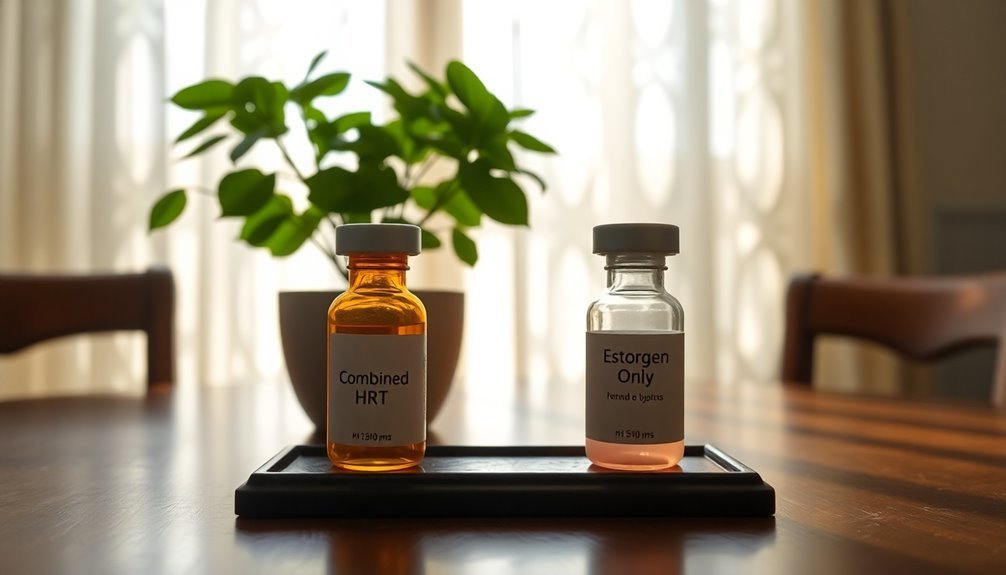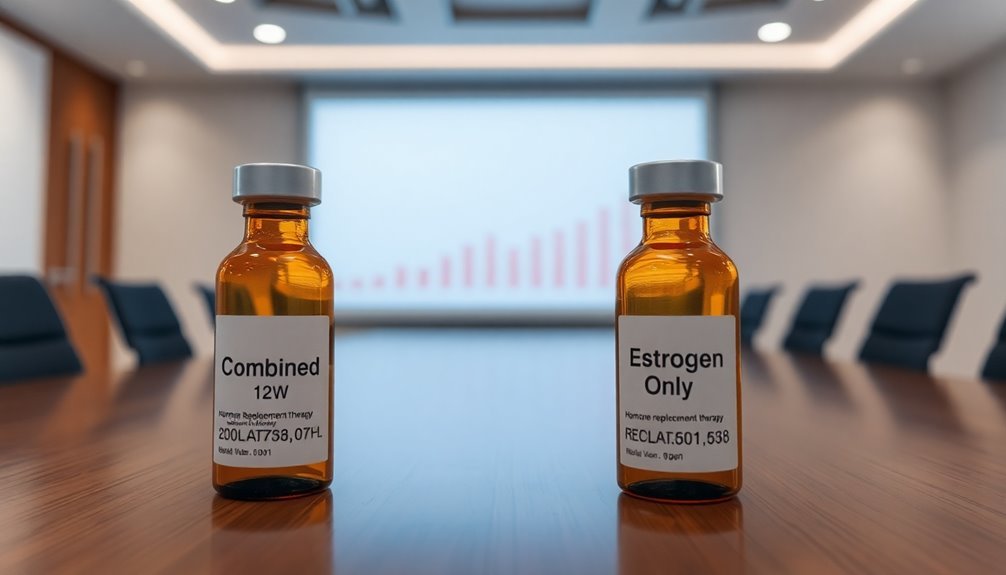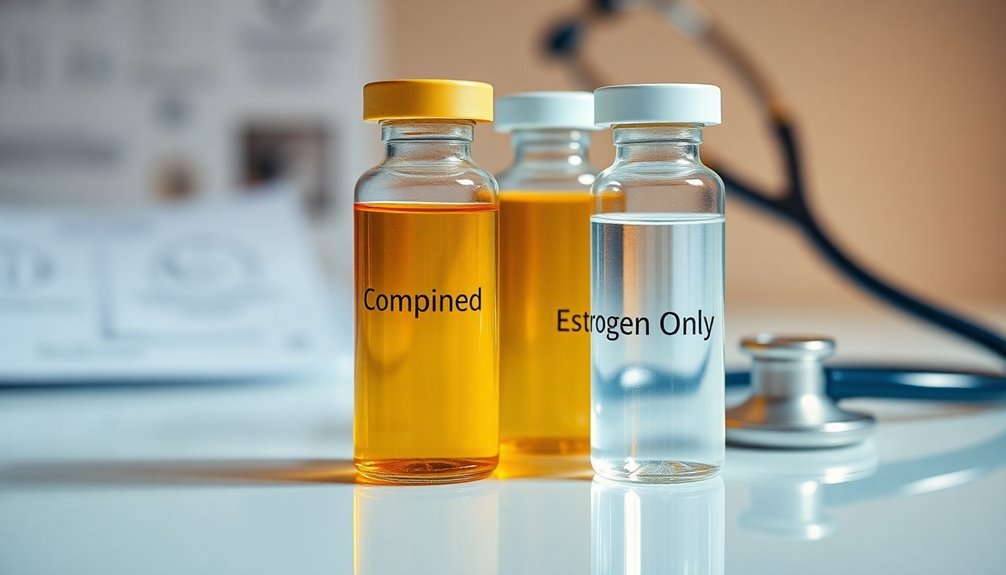When deciding between combined HRT and estrogen-only HRT, it's essential to weigh their distinct benefits and risks. Combined HRT, comprising estrogen and progestogen, reduces endometrial cancer risk but may increase cardiovascular events and certain cancers. Estrogen-only HRT effectively alleviates menopausal symptoms and boosts muscle strength, yet elevates breast and endometrial cancer risks. Both types improve vasomotor symptoms, bone health, and cognitive function. Socioeconomic factors, including income and insurance coverage, also influence access and usage patterns. Clinical guidelines emphasize personalized treatment, considering individual risk factors. For a deeper understanding, explore further into the nuances of these therapies.
Key Takeaways
- Combined HRT reduces osteoporosis risk and improves sleep quality, but it has increased cancer and cardiovascular risks.
- Estrogen-only HRT maintains muscle strength and improves vaginal health, though it increases breast and endometrial cancer risks.
- Both HRT types effectively manage vasomotor symptoms and improve bone health and cognitive function.
- Individual risk factors and patient preferences should guide the choice between combined and estrogen-only HRT.
- Socioeconomic factors and physician recommendations significantly influence HRT access and usage patterns.
Understanding Combined HRT

Together, the main purpose of HRT is to aid women with a uterus in reducing the risk of endometrial cancer by incorporating both estrogen and progestogen. This combination is vital since the progestogen component counteracts estrogen's proliferative effects on the endometrial lining, decreasing the risk of hyperplasia and cancer. You're faced with two primary administration methods: continuous-combined therapy, most suitable for post-menopausal women, and cyclic therapy, appropriate during perimenopause.
Continuous-combined therapy involves daily intake of both hormones, available in various forms like pills, patches, or IUDs. Some women may require estrogen-only HRT, especially after a hysterectomy, highlighting the importance of individualized treatment plans. Incorporating probiotic-rich foods into your diet can have positive effects on mental well-being and may complement the benefits of HRT by enhancing mood regulation and reducing symptoms of anxiety.
When contemplating the cost comparison of combined HRT, it's crucial to weigh the immediate financial impact against potential long-term outcomes. While initially, combined HRT might seem more expensive due to regular medical consultations and monitoring, it can prevent significant healthcare expenses associated with untreated menopausal symptoms or subsequent health complications. However, long-term outcomes are multifaceted.
The therapy slightly increases risks for breast and ovarian cancers and cardiovascular events, which you should balance against benefits like reduced osteoporosis risk and improved quality of life. Customizing your HRT plan with a healthcare provider ensures optimal results while minimizing risks and costs.
Exploring Estrogen-Only HRT
When considering estrogen-only HRT, you'll find it's especially beneficial for women who've undergone a hysterectomy, since it effectively reduces hot flashes and night sweats without increasing breast cancer or coronary heart disease risks. Additionally, estrogen-only HRT can help maintain muscle strength, which is important for overall health. However, it's essential to be aware of potential adverse effects, such as breast tenderness and hormonally-sensitive migraines, and to use it cautiously if there's a history of blood clots or stroke. While estrogen-only HRT offers many benefits, it's important to consider that this therapy can also contribute to osteoporosis prevention, which is a significant health risk during menopause. Tailoring treatment to individual needs and minimizing duration of use can help maximize benefits while mitigating risks.
Estrogen-Only HRT Benefits
Although grasping hormone replacement therapy options can be intricate, comprehending the advantages of estrogen-only HRT provides clarity for many women. This therapy excels in symptom relief, particularly for hot flashes and night sweats, reducing their frequency by about 85%. For those who have had a hysterectomy, estrogen-only HRT offers a personalized therapy approach, addressing specific needs without the heightened risk of breast cancer associated with combined HRT. Moreover, estrogen-only HRT significantly enhances vaginal dryness, improving overall quality of life. Unlike some other treatments, estrogen-only MHT is not associated with weight gain, allowing women to manage their weight effectively during the therapy.
| Benefit | Description | Effectiveness |
|---|---|---|
| Symptom Relief | Reduces hot flashes and night sweats | 85% reduction |
| Vaginal Health | Alleviates dryness and enhances comfort | Highly effective |
| Bone Health | Reduces risk of post-menopausal fractures | Noteworthy |
| Sleep Improvement | Enhances sleep by decreasing hot flash frequency | Improved quality |
| Weight Management | Not linked with weight gain | Neutral effect |
Estrogen-only HRT comes in diverse forms, such as patches, tablets, and gels, enabling a personalized treatment plan. For women undergoing early menopause, initiating estrogen therapy until the average menopause age of 50 is recommended. Yearly consultations with healthcare providers guarantee the therapy remains advantageous and tailored to your evolving needs.
Risks of Estrogen Use
While estrogen-only HRT offers significant benefits, it's crucial to weigh these against potential risks. One of the primary concerns is the increased risk of breast cancer, which is duration-dependent and decreases after stopping HRT. For every 10,000 women using estrogen-only HRT for a year, the risk is slightly elevated compared to those not on HRT. Ovarian cancer risk also rises with prolonged use, though stopping the therapy gradually reduces this risk. Endometrial cancer presents another significant risk, particularly for women with an intact uterus. It's important to note that oestrogen-only HRT is typically prescribed for individuals who have had a hysterectomy, as it can increase womb cancer risk in those with an intact uterus. Behavioral changes and lifestyle modifications can play an essential role in risk management.
- Breast Cancer: Slightly increased risk, more pronounced with longer usage.
- Ovarian Cancer: One extra case per 1,000 women over five years.
- Endometrial Cancer: Increased likelihood, particularly in women with an intact uterus.
Furthermore, estrogen-only HRT is associated with other risks, such as blood clots, stroke, and exacerbation of hormonally-sensitive migraines. Long-term implications include potential impacts on heart disease, particularly in older women. In managing these risks, it's vital to consider both medical advice and personal health practices, ensuring that the benefits and drawbacks are carefully balanced.
Suitability for Hysterectomy
For women who've had a total hysterectomy, estrogen-only hormone replacement therapy (HRT) becomes a suitable option, effectively alleviating menopausal symptoms without the need for progestogen. This approach is particularly beneficial in managing symptoms associated with surgical menopause, such as hot flashes and vaginal dryness. By focusing solely on estrogen replacement, you can maintain bone health, which is essential in postmenopausal women. Since estrogen is crucial for various HRT forms, it plays a significant role in addressing these menopausal challenges.
Estrogen-only HRT is available in various forms, allowing personalized administration to suit individual needs. The table below outlines different administration methods:
| Administration Method | Description | Indication |
|---|---|---|
| Tablets | Oral intake, convenient daily dose | Systemic symptoms |
| Patches | Applied to skin, provides continuous release | Systemic symptoms |
| Gel | Applied to skin, flexible dosing | Systemic symptoms |
| Spray | Applied to skin, controlled application | Systemic symptoms |
Choosing the appropriate form of estrogen-only HRT should be guided by your healthcare provider. They consider your specific symptoms and risks, ensuring the best therapeutic outcomes. Compared to combined HRT, estrogen-only options present fewer potential risks, such as breast cancer. By selecting the right HRT form, you can effectively manage surgical menopause while preserving bone health, tailored to your post-hysterectomy needs.
Symptom Relief Comparison

When comparing the effectiveness of combined versus estrogen-only HRT in managing menopausal symptoms, you'll find both notably reduce vasomotor symptoms like hot flashes by approximately 80%. Combined therapy, incorporating progesterone, is particularly effective for women with an intact uterus, offering additional benefits such as improved sleep quality and reduced osteoporosis risk. Additionally, progesterone in combination therapy plays a protective role beyond the uterus. Introducing probiotic-rich ingredients into your diet can also enhance overall mental well-being, which is beneficial during menopause. However, estrogen-only therapy presents a lower risk profile in women post-hysterectomy, providing substantial symptom relief without the need for progesterone.
Comparative Effectiveness Analysis
In comparing the symptom relief provided by combined hormone replacement therapy (HRT) and estrogen-only HRT, both treatments demonstrate significant effectiveness in alleviating vasomotor symptoms such as hot flashes and night sweats. While both therapies are effective, your treatment decision should consider the different adverse effects associated with each option. Combined HRT often involves a complex risk-benefit profile due to its increased risk of breast cancer and cardiovascular events over long-term use. Conversely, estrogen-only HRT, typically recommended for women without a uterus, may present a lower risk of breast cancer. Persistent racial and socioeconomic disparities in menopause care highlight the need for addressing these inequities to improve access to HRT and overall menopause management.
Here's a detailed comparison to guide you:
- Symptom Relief: Both HRT types effectively reduce vasomotor symptoms.
- Adverse Effects: Combined HRT has higher associated risks, including breast cancer and cardiovascular diseases.
- Individualized Care: Decisions should factor in personal health history and specific needs.
Both therapies demand regular monitoring and assessment, ensuring best symptom relief while minimizing potential adverse effects. The decision between combined and estrogen-only HRT requires a personalized approach, emphasizing shared decision-making. Careful consideration of your health profile will lead to informed treatment decisions, balancing effectiveness with safety.
Menopausal Symptom Management
Although managing menopausal symptoms can be challenging, both combined and estrogen-only hormone replacement therapies offer effective solutions tailored to individual needs. Combined HRT excels in hormone regulation by mitigating vasomotor symptoms like hot flushes, night sweats, and mood swings, while also addressing vaginal dryness and joint pain. Its ability to enhance sleep quality and reduce osteoporosis risk adds to its efficacy. Additionally, it has been noted that combined HRT may improve cognitive function and memory, contributing to overall mental well-being. Importantly, the inclusion of progesterone in combined HRT offers protective benefits against endometrial cancer, though it comes with side effects, such as increased breast cancer risk.
On the other hand, estrogen-only HRT is particularly beneficial for women post-hysterectomy, offering targeted relief from vasomotor symptoms and enhancing vaginal health through localized application. This therapy can improve skin and hair quality, providing an extensive approach to symptom management. However, estrogen-only therapy's side effects include a heightened risk of uterine cancer due to unopposed endometrial stimulation, underscoring the need for vigilant hormone regulation and monitoring.
Ultimately, both therapies require careful consideration of individual risk profiles and collaborative healthcare consultations to optimize menopausal symptom relief while minimizing potential adverse effects.
Evaluating Cancer Risks
Evaluating the cancer risks associated with hormone replacement therapy (HRT) requires careful consideration of the differences between combined and estrogen-only therapies. When considering the long-term risks, it's important to recognize that combined HRT slightly increases the risk of breast cancer, especially with prolonged use, and this risk decreases but doesn't immediately return to baseline after stopping. For estrogen-only HRT, the risk of breast cancer is generally lower than combined HRT but still present, with some studies indicating a 30% increase.
- Combined HRT is linked to a higher risk of ovarian cancer, which gradually decreases after discontinuing the therapy.
- Estrogen-only HRT also carries a slightly higher risk for ovarian cancer, with the greatest risk in current users.
- The inclusion of progestin in combined HRT reduces the risk of endometrial cancer, unlike estrogen-only HRT, which elevates this risk. Additionally, hormone therapy can come in different forms such as conjugated equine estrogens, which are commonly used in managing menopausal symptoms.
Survival rates can be impacted by these cancer risks, as certain therapies may influence detection and treatment outcomes. For instance, combined HRT can result in denser breast tissue, complicating mammogram interpretations. Understanding these subtleties assists in making well-informed decisions regarding HRT options.
Cardiovascular Concerns

When contemplating hormone replacement therapy (HRT) for cardiovascular health, the type of therapy—combined versus estrogen-only—plays a significant role in determining risk. Combined estrogen-progestogen HRT has shown a nuanced cardiovascular risk profile. While studies like the Heart and Estrogen/progestin Replacement Study (HERS) indicate no significant difference in nonfatal myocardial infarction (MI) outcomes, long-term use can escalate the risk of heart disease, stroke, and pulmonary embolism. Additionally, combined HRT offers no angiographic advantage in coronary stenosis cases, potentially increasing cardiovascular events initially. Importantly, estrogen-only HRT is associated with no or reduced risk of coronary heart disease, according to several guidelines, including those from the IMS.
On the contrary, estrogen-only HRT presents a more favorable heart health outlook, especially in women who've undergone hysterectomy. The initiation of estrogen-only HRT is associated with reduced coronary heart disease risk, aligning with International Menopause Society guidelines. Despite this, the Estrogen Replacement and Atherosclerosis (ERA) Trial showed no angiographic improvement with estrogen-only therapy in women with coronary stenosis.
In comparison, combined HRT poses a slightly higher cardiovascular risk than estrogen-only HRT, particularly within the first treatment year. Both therapies increase venous thromboembolism risk, with combined HRT having a higher propensity. Personalizing hormone therapy based on individual cardiovascular risk factors is, consequently, imperative.
Mortality and Timing
Mortality findings in hormone replacement therapy (HRT) reveal a complex interplay between treatment type, timing, and individual health factors. Evidence suggests that combined HRT users experience a 9% reduction in all-cause mortality compared to non-users, while estrogen-only HRT doesn't alter mortality outcomes to a considerable extent. Age-specific analyses indicate that combined HRT is associated with lower hazard ratios across various age brackets (46-65 years), highlighting critical mortality implications.
The timing effects of HRT initiation significantly influence longevity. Starting HRT closer to menopause—typically in the early 50s—can mitigate heart disease risks, unlike initiation post-60. This timing also correlates with reduced biological aging discrepancies, promoting longevity. Mortality benefits appear more noticeable with shorter HRT durations, ranging from four to eight years.
Consider these key findings:
- Early HRT initiation: Reduced heart disease risk and biological aging discrepancies.
- Combined HRT: Lower all-cause mortality across various ages.
- Estrogen-only therapy: No remarkable mortality change but reduced breast cancer mortality in hysterectomized women.
These insights underscore the importance of personalized HRT strategies, considering age, timing, and individual health conditions, to optimize mortality outcomes and longevity.
Trends in HRT Use

As hormone replacement therapy (HRT) continues to evolve, you'll notice significant trends shaping its use and market growth. The market is projected to reach $36,033.8 million by 2030, with a CAGR of 6.48% from 2024 to 2030. Key factors driving this growth include an aging population, increasing cases of hormonal imbalance, and advancements in drug delivery systems like transdermal patches and gels. North America leads in regional dominance, expected to maintain this through 2030.
| Trend | Details |
|---|---|
| Market Size | $36,033.8 million by 2030 |
| Growth Rate | CAGR of 6.48% (2024-2030) |
| Key Drivers | Aging population, hormonal disorders, advanced delivery systems |
| Regional Dominance | North America |
HRT treatment options are becoming more personalized, with estrogen-only therapies for hysterectomy patients and combined options for others, reflecting varied hormonal needs. The rise in awareness about menopause management and regenerative medicine also fuels demand. Safety concerns, such as risks of breast cancer and cardiovascular issues, necessitate stringent regulatory scrutiny. However, the development of bioidentical hormones and novel therapeutics offers promising solutions for addressing hormonal imbalances. The landscape is marked by increased R&D activities and a surge in drug approvals, although challenges like high costs and regulatory barriers persist.
Socioeconomic Disparities
When analyzing HRT usage among various demographics, you'll notice that socioeconomic factors, such as income and education, greatly influence access to menopause treatment. Lower-income individuals and those with less education are less likely to receive HRT, partially due to limited healthcare access and cultural barriers.
Additionally, racial and ethnic disparities, particularly among Non-Hispanic Black women, highlight the necessity for targeted interventions to improve equitable HRT access.
HRT Usage Among Demographics
A notable disparity in Hormone Replacement Therapy (HRT) usage exists across different socioeconomic statuses. Socioeconomic barriers play a crucial role, as moderate to high-income women are three times more likely to use HRT compared to those with lower income. The prescribing rates are 29% lower in the most deprived quintile, despite a greater need for menopause care.
Furthermore, physician encouragement markedly impacts HRT usage, with 58% of women using HRT when encouraged, versus 20% with ambivalent recommendations.
Ethnic disparities further compound these issues. Non-Hispanic Black and Hispanic women exhibit lower HRT usage compared to non-Hispanic White women, with non-Hispanic Black women showing an 88% decline in HRT prevalence over time. Educational attainment positively influences HRT usage among non-Hispanic Black and Hispanic women, yet this trend doesn't extend to non-Hispanic White women.
Key findings include:
- Higher family income and insurance coverage are linked to increased HRT usage.
- Black and Hispanic women report more severe menopausal symptoms but have lower HRT usage.
- Geographic disparities indicate lower HRT prescribing rates in deprived areas, highlighting unmet needs.
Understanding these disparities is essential for addressing inequities in menopause care.
Access to Menopause Treatment
Few aspects of healthcare highlight socioeconomic disparities as starkly as access to menopause treatment. Access disparities in hormone replacement therapy (HRT) are influenced by socioeconomic factors, with prescribing rates 29% lower in the most deprived quintile compared to the most affluent.
Socioeconomic factors, such as higher family income and insurance coverage, are strongly associated with increased use of menopausal hormone therapy (MHT). Educational attainment also plays a role, particularly among non-Hispanic Black and Hispanic women, although non-Hispanic White women don't exhibit the same pattern.
Lower-income women report more severe menopausal symptoms, which may be exacerbated by limited access to healthcare resources. The intersection of race, ethnicity, and socioeconomic status contributes to these access disparities. For instance, non-Hispanic Black women have experienced the lowest prevalence and greatest decline in MHT use over recent decades, signaling an unmet need for menopause care in disadvantaged groups.
Socioeconomic deprivation is linked not only to reduced HRT prescribing but also to increased health risks, such as cardiovascular disease and diabetes, which influence clinical decisions. Addressing these disparities requires targeted interventions and increased awareness within healthcare practices.
Cultural Barriers in HRT Use
Cultural beliefs and socioeconomic disparities form significant barriers to hormone replacement therapy (HRT) use among diverse populations. Your access to HRT can be influenced by various factors, including cultural norms and economic status. Women from lower socioeconomic backgrounds are 30% less likely to receive HRT compared to their affluent counterparts. This disparity isn't solely financial; it's tethered to cultural beliefs surrounding menopause and healthcare access.
- Women of moderate to high income are thrice as likely to use HRT compared to low-income women.
- Ethnic minority groups report lower uptake of preventive health measures and HRT use compared to white women.
- Cultural perceptions of menopause symptoms differ, influencing the willingness to seek treatment.
Healthcare access is further compromised by healthcare providers' recommendations, which can be inconsistent and biased by socioeconomic status. Studies show 58% of women use HRT when actively encouraged by their physician, compared to a mere 20% with lukewarm endorsements.
Additionally, cultural practices in male-dominated societies discourage menopause treatment, affecting adherence to care. These barriers necessitate culturally sensitive interventions to address disparities in HRT access, ensuring equitable treatment approaches across diverse populations.
Risk-Benefit Analysis

When analyzing the risk-benefit balance of hormone replacement therapies, it's crucial to examine both combined HRT and estrogen-only therapy regarding their unique profiles. Conducting treatment evaluations involves a thorough risk evaluation to weigh increased risks against potential benefits.
Combined HRT presents an elevated risk of coronary heart disease, strokes, blood clots, and invasive breast cancer. There's also compromised mammography interpretation due to increased breast density. However, it offers significant protective effects against endometrial and colorectal cancers, reduces osteoporotic fractures, and alleviates menopausal symptoms. The treatment is particularly advantageous for women with an intact uterus due to the inclusion of progesterone.
In contrast, estrogen-only therapy, suitable for women post-hysterectomy, carries a similar stroke risk but is associated with a lower breast cancer risk compared to combined HRT. It effectively reduces osteoporotic fractures and menopausal symptoms without increasing coronary heart disease risk. However, it may cause uterine lining hyperplasia in women with an intact uterus and shows potential cognitive risks in older women.
Both therapies require careful consideration of individual risk factors, including age and health status, to optimize the risk-benefit ratio, ensuring each patient's treatment is tailored to their specific needs and circumstances.
Clinical Practice Guidelines
In clinical practice guidelines for hormone replacement therapy (HRT), it's important to frequently ponder the specifics of combined HRT versus estrogen-only approaches to optimize patient care. Combined therapy, involving estrogen and progestogen, is typically recommended for women with an intact uterus to maintain hormone balance and mitigate the risk of uterine cancer. Estrogen-only therapy is generally suitable for women post-hysterectomy. Both therapies aim to alleviate menopausal symptoms, but they come with varying side effects and considerations.
Key elements to ponder include:
- Duration and Discontinuation: Systemic hormone therapy (HT) should be administered at the lowest dose and shortest duration to minimize serious side effects. Regular reassessment is necessary to balance benefits and risks.
- Indications and Administration: Systemic estrogen, with or without progestin, effectively treats vasomotor symptoms. Topical methods are preferred for vaginal symptoms due to fewer adverse effects.
- Shared Decision-Making: Tailor therapy based on clinical factors and patient preferences. Discuss potential side effects, such as increased breast cancer risk, and verify age-appropriate screenings.
For effective management, ongoing monitoring and follow-up are essential to reassess the need for HRT and adjust the treatment plan as needed.
Frequently Asked Questions
Can HRT Therapy Affect Mental Health or Mood Swings?
Yes, HRT therapy can affect mental health and mood swings. You might experience mood swings and anxiety initially as your body adjusts to the hormone balance. Systemically administered HRT could increase depression risk, especially in the first year.
However, HRT can enhance emotional well-being by alleviating menopause-related symptoms like hot flashes. Managing these effects involves monitoring your emotional state and consulting healthcare professionals for personalized strategies and adjustments.
What Are the Alternative Treatments to HRT for Menopause Symptoms?
Imagine menopause as a storm; herbal remedies and cognitive behavior therapy (CBT) are your lighthouse and anchor.
Herbal remedies like phytoestrogens and black cohosh offer potential relief, though evidence is mixed and safety concerns exist.
CBT shines as a beacon, effectively reducing the bother of hot flashes and night sweats.
Both approaches symbolize a safer harbor, steering you through turbulent symptoms with evidence-based efficacy and detailed guidance.
How Does Lifestyle Impact the Effectiveness of HRT Therapy?
Your lifestyle greatly impacts HRT effectiveness. Incorporate regular exercise; it enhances bone density and cardiovascular health, amplifying HRT's effects. Managing stress through techniques like meditation supports hormonal balance, reducing menopause symptoms.
A nutrient-rich diet, especially in calcium and vitamin D, complements HRT's benefits on bone health. Avoid triggers like caffeine and alcohol to help manage symptoms. Maintaining these healthy practices optimizes HRT therapy's overall effectiveness and safety.
Are There Any Dietary Restrictions While on HRT Therapy?
Picture your body as a finely tuned engine. You need to follow nutritional recommendations to keep it running smoothly during HRT therapy. Limit caffeine and phosphorus to avoid negative supplement interactions affecting calcium absorption. Cut back on saturated fats and sugar to enhance estrogen metabolism. Incorporate calcium-rich and phytoestrogen-rich foods to support bone health.
How Do Genetic Factors Influence the Choice of HRT Therapy?
Genetic influences play a pivotal role in your choice of hormone therapy, emphasizing personalized medicine. Your genetic makeup, including mutations like BRCA1 or BRCA2, can dictate how your body responds to HRT. Family history, particularly breast cancer, further informs your therapy choice. Healthcare providers assess these genetic factors to tailor hormone therapy, balancing benefits against risks. Understanding your genetic predispositions guarantees a more effective and safer HRT decision.
Conclusion
In evaluating HRT options, combined therapy generally offers more extensive symptom relief, especially for vasomotor symptoms, compared to estrogen-only therapy. However, combined HRT carries a slightly increased breast cancer risk, with studies showing a 24% higher risk after five years of use. Cardiovascular risks are also a concern, particularly with combined HRT. Ultimately, the choice should be individualized, considering patient history and risk factors, and aligned with clinical guidelines to optimize outcomes and minimize adverse effects.




